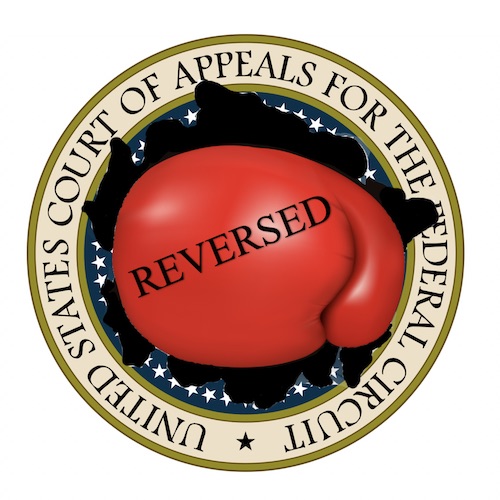“[T]he district court erred in evaluating [the claim element] as a binary choice between a single-component structure and a multi-component structure, rather than evaluating the evidence to determine whether a reasonable juror could find that the accused products perform substantially the same function, in substantially the same way, achieving substantially the same result as the claims.” – CAFC
 On March 9, the U.S. Court of Appeals for the Federal Circuit (CAFC) vacated and reversed the U.S. District Court for the Central District of California’s decision to grant summary judgment in favor of defendant Munchkin, Inc. (Munchkin) for noninfringement of U.S. Patent Nos. 8,899,420 (the ‘420 patent) and 6,974,029 (the ‘029 patent), held by plaintiffs Edgewell Personal Care Brands, LLC and International Refills Company, Ltd. (collectively Edgewell). Edgewell manufactures and sells the Diaper Genie, a diaper pail system with two main components: 1) a pail for collection of soiled diapers; and 2) a replaceable cassette within the pail that forms a wrapper around the soiled diapers. The ‘420 and ‘029 patents relate to improvements in the cassette design. Edgewell filed suit against Munchkin for infringement of these patents for selling refill cassettes marketed as being compatible with Edgewell’s Diaper Genie. Edgewell appealed the district court’s decision to grant summary judgment to Munchkin for noninfringement of both patents.
On March 9, the U.S. Court of Appeals for the Federal Circuit (CAFC) vacated and reversed the U.S. District Court for the Central District of California’s decision to grant summary judgment in favor of defendant Munchkin, Inc. (Munchkin) for noninfringement of U.S. Patent Nos. 8,899,420 (the ‘420 patent) and 6,974,029 (the ‘029 patent), held by plaintiffs Edgewell Personal Care Brands, LLC and International Refills Company, Ltd. (collectively Edgewell). Edgewell manufactures and sells the Diaper Genie, a diaper pail system with two main components: 1) a pail for collection of soiled diapers; and 2) a replaceable cassette within the pail that forms a wrapper around the soiled diapers. The ‘420 and ‘029 patents relate to improvements in the cassette design. Edgewell filed suit against Munchkin for infringement of these patents for selling refill cassettes marketed as being compatible with Edgewell’s Diaper Genie. Edgewell appealed the district court’s decision to grant summary judgment to Munchkin for noninfringement of both patents.
Claim Construction
Reviewing the decision under the law of the Ninth Circuit, the CAFC first turned to the ‘420 patent. The ‘420 patent covers a cassette with a clearance in its bottom portion. This cassette may be placed into a pail that has an “interfering member” possessing a shape complimentary to the cassette. The clearance in the cassette prevents users from installing it upside down. The parties agreed that the cassette itself contained a clearance but disputed whether the term “clearance” covers circumstances where there is no space between a cassette and another structure after installation. Specifically, the parties disputed if the claims required clearance space between the annular wall which defined the chamfer clearance and the pail itself when the cassette was installed. The district court construed the “clearance” claim of the ‘420 patent to cover the remaining clearance between the cassette and another structure after installation, but not the space where the cassette and other structure are locked together. Thus, because there was no space between the cassette and the pail in Munchkin’s product as determined to be required for infringement of the ‘420 patent, the district court granted Munchkin’s summary judgment motion of noninfringement.
The CAFC found that the district court’s summary judgment claim construction imposed further limitations on the original claim construction, so it could therefore be reviewed de novo. Citing Hewlett–Packard Co. v. Bausch & Lomb Inc., the CAFC opined that “an apparatus claim is generally to be construed according to what the apparatus is, not what the apparatus does.” 909 F.2d 1464, 1468 (Fed. Cir. 1990). Therefore, the court held that absent express limitation, the term “clearance” should be construed to cover all uses of the claimed cassette. The court found that the specification discloses multiple embodiments that contain either clearance or a lack thereof after installation, making note that the term “passes closely” suggests that there would be clearance space after installation in at least one embodiment. Furthermore, the CAFC held that the specification does not support the district court’s construction because this construction would preclude the cassette from engaging with the complimentary structure in the pail, which requires clearance for proper engagement. The court found that the claim does not require clearance after insertion, because the cassette clearance ensures proper installation whether or not space remains after insertion. Thus, the CAFC vacated the district court’s noninfringement summary judgment verdict regarding the ‘420 patent.
Doctrine of Equivalents
The ‘029 patent refers to another cassette with an annular cover that extends over the pleated tubing housed therein. This cover has a section that can be torn off, leaving a peripheral gap to allow access to the tubing. The district court construed “annular cover” to be a single, ring-shaped cover with at least a top portion and inner portion, and “tear-off outwardly projecting section” to mean a section initially a part of the annular cover that could be torn off,” both of which are a part of a single structure. The district court also construed “engage/engaging” to mean “attach/attached to.” Munchkin’s cassettes include a two-part cover, with one including an inner piece of molded plastic and out piece of shrimp wrap designed to be torn off before installation, and another similarly including an inner piece of molded plastic but use a plastic “blister cap” instead of shrink wrap. Edgewell accused Munchkin of infringement under the doctrine of equivalents, but the district court found noninfringement here too. According to the district court, no reasonable jury could find that Munchkin’s cassettes satisfy the “annular cover” and “tear-off section” limitations under the doctrine of equivalents because this would vitiate the tear-off section limitation.
The CAFC agreed with the district court’s construction of “annular cover” and “tear-off section” as part of a single structure, finding support in the plain language of the claims and the written description. The CAFC also agreed with the district court’s construction of “engage” to mean “attach,” because the plain language of the claims and the written description both require more than mere contact. However, the CAFC found that the district court erred in granting summary judgment of noninfringment of the ‘029 patent under the doctrine of equivalents. Citing Warner-Jenkinson Co., Inc. v. Hilton Davis Chem. Co., the CAFC stated that the vitiation doctrine ensures the application of the doctrine of equivalents does not “effectively eliminate [a claim] element in its entirety.” 520 U.S. 17, 29 (1997). Claim vitiation, according to the CAFC, is “a legal determination that the evidence is such that no reasonable jury could determine two elements to be equivalent.” Therefore, the CAFC found that the district court erred in concluding that Edgewell’s theory of infringement under the doctrine of equivalents renders meaningless the “annular cover” claim element. The court explained:
[T]he district court erred in evaluating [the annular cover claim element] as a binary choice between a single-component structure and a multi-component structure, rather than evaluating the evidence to determine whether a reasonable juror could find that the accused products perform substantially the same function, in substantially the same way, achieving substantially the same result as the claims.
The CAFC, in heeding Edgewell’s expert witness testimony, found that Munchkin’s products infringed the ‘029 patent because their annular covers perform the same function, in the same way, to achieve the same result as the claimed annular cover. In one Munchkin cassette, the annular cover provides the same function by extending over the housing of the pleated tubing while still providing a means of access, and it performs the same function where the plastic portion engages the inner wall of the annular body, and the shrink-wrap that engages the outer wall may be torn-off. Further, the result is the same because a peripheral gap is exposed once the shrink-wrap is torn off the housing, allowing the tubing to be accessed. Similarly, in another Munchkin cassette the annular housing comprises a plastic portion that engages the inner wall, and an outer wall-engaging blister cap that, similarly to the shrink-wrap, may also be torn off. This also reveals a peripheral gap that allows access to the tubing. Therefore, the CAFC held that these similarities provided sufficient evidence to create a genuine issue of material fact for a jury to resolve, and thus reversed the district court’s noninfringment summary judgment verdict regarding the ‘029 patent.
The court ultimately held that the district court based its grant of summary judgment of noninfringement of the ’420 patent on an erroneous construction, vacating and remanding, and . that it erred in granting Munchkin summary judgment of noninfringement of the ’029 patent, reversing and remanding.

![[IPWatchdog Logo]](https://ipwatchdog.com/wp-content/themes/IPWatchdog%20-%202023/assets/images/temp/logo-small@2x.png)

![[[Advertisement]]](https://ipwatchdog.com/wp-content/uploads/2023/01/2021-Patent-Practice-on-Demand-1.png)
![[Advertisement]](https://ipwatchdog.com/wp-content/uploads/2024/04/Patent-Litigation-Masters-2024-sidebar-early-bird-ends-Apr-21-last-chance-700x500-1.jpg)

![[Advertisement]](https://ipwatchdog.com/wp-content/uploads/2021/12/WEBINAR-336-x-280-px.png)
![[Advertisement]](https://ipwatchdog.com/wp-content/uploads/2021/12/2021-Patent-Practice-on-Demand-recorded-Feb-2021-336-x-280.jpg)
![[Advertisement]](https://ipwatchdog.com/wp-content/uploads/2021/12/Ad-4-The-Invent-Patent-System™.png)







Join the Discussion
No comments yet.